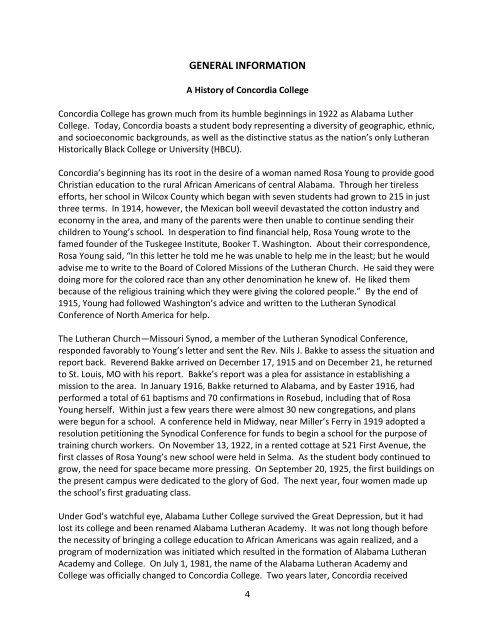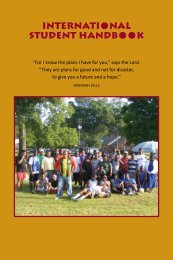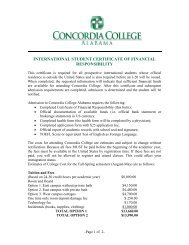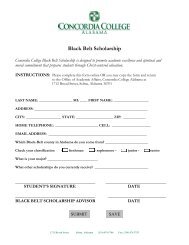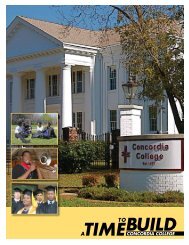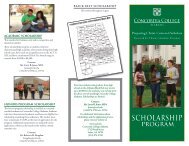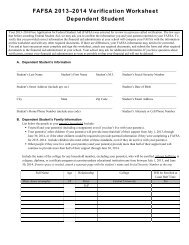Academic Catalog - Concordia College
Academic Catalog - Concordia College
Academic Catalog - Concordia College
You also want an ePaper? Increase the reach of your titles
YUMPU automatically turns print PDFs into web optimized ePapers that Google loves.
GENERAL INFORMATION<br />
A History of <strong>Concordia</strong> <strong>College</strong><br />
<strong>Concordia</strong> <strong>College</strong> has grown much from its humble beginnings in 1922 as Alabama Luther<br />
<strong>College</strong>. Today, <strong>Concordia</strong> boasts a student body representing a diversity of geographic, ethnic,<br />
and socioeconomic backgrounds, as well as the distinctive status as the nation’s only Lutheran<br />
Historically Black <strong>College</strong> or University (HBCU).<br />
<strong>Concordia</strong>’s beginning has its root in the desire of a woman named Rosa Young to provide good<br />
Christian education to the rural African Americans of central Alabama. Through her tireless<br />
efforts, her school in Wilcox County which began with seven students had grown to 215 in just<br />
three terms. In 1914, however, the Mexican boll weevil devastated the cotton industry and<br />
economy in the area, and many of the parents were then unable to continue sending their<br />
children to Young’s school. In desperation to find financial help, Rosa Young wrote to the<br />
famed founder of the Tuskegee Institute, Booker T. Washington. About their correspondence,<br />
Rosa Young said, “In this letter he told me he was unable to help me in the least; but he would<br />
advise me to write to the Board of Colored Missions of the Lutheran Church. He said they were<br />
doing more for the colored race than any other denomination he knew of. He liked them<br />
because of the religious training which they were giving the colored people.” By the end of<br />
1915, Young had followed Washington’s advice and written to the Lutheran Synodical<br />
Conference of North America for help.<br />
The Lutheran Church—Missouri Synod, a member of the Lutheran Synodical Conference,<br />
responded favorably to Young’s letter and sent the Rev. Nils J. Bakke to assess the situation and<br />
report back. Reverend Bakke arrived on December 17, 1915 and on December 21, he returned<br />
to St. Louis, MO with his report. Bakke’s report was a plea for assistance in establishing a<br />
mission to the area. In January 1916, Bakke returned to Alabama, and by Easter 1916, had<br />
performed a total of 61 baptisms and 70 confirmations in Rosebud, including that of Rosa<br />
Young herself. Within just a few years there were almost 30 new congregations, and plans<br />
were begun for a school. A conference held in Midway, near Miller’s Ferry in 1919 adopted a<br />
resolution petitioning the Synodical Conference for funds to begin a school for the purpose of<br />
training church workers. On November 13, 1922, in a rented cottage at 521 First Avenue, the<br />
first classes of Rosa Young’s new school were held in Selma. As the student body continued to<br />
grow, the need for space became more pressing. On September 20, 1925, the first buildings on<br />
the present campus were dedicated to the glory of God. The next year, four women made up<br />
the school’s first graduating class.<br />
Under God’s watchful eye, Alabama Luther <strong>College</strong> survived the Great Depression, but it had<br />
lost its college and been renamed Alabama Lutheran Academy. It was not long though before<br />
the necessity of bringing a college education to African Americans was again realized, and a<br />
program of modernization was initiated which resulted in the formation of Alabama Lutheran<br />
Academy and <strong>College</strong>. On July 1, 1981, the name of the Alabama Lutheran Academy and<br />
<strong>College</strong> was officially changed to <strong>Concordia</strong> <strong>College</strong>. Two years later, <strong>Concordia</strong> received<br />
4


